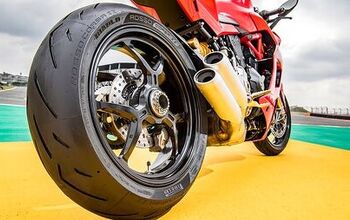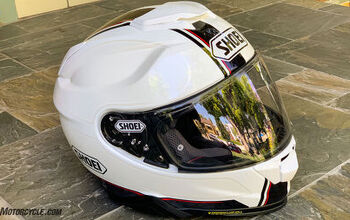MO Tested: Shoei VFX-EVO Helmet Review
Good ol' faithful - one of our favorite off-road helmets ever.
Helmets are a lot like shoes, and like a good pair of shoes, the right helmet can be incredibly versatile and can complement a variety of different outfits, or gear sets in this case, for an assortment of various riding disciplines. The Shoei VFX-Evo has been my number one go-to off-road helmet since the day I got it back in January, and I’ve been reaching for it almost exclusively anytime any sort of dirt riding is on the menu.
Shoei VFX-EVO
| Aesthetics | 9.5/10 |
| Protection | 9.0/10 |
| Value | 9.0/10 |
| Comfort/Fit | 9.5/10 |
| Quality/Design | 9.75/10 |
| Weight | 9.0/10 |
| Options/Selection | 9.0/10 |
| Innovation | 8.75/10 |
| Weather Suitability | 8.5/10 |
| Desirable/Cool Factor | 10.0/10 |
| Overall Score | 92/100 |
One can’t help but think of Shoei anytime premium motorcycle helmets are brought up. Since 1959, says Shoei, every Shoei has been handmade in Japan utilizing a sophisticated process that involves over 50 people for each and every helmet. Shoei doesn’t offer multiple versions of the same helmet with different technologies and varying price points. Rather, the company only offers what they consider to be the best for the category, and the VFX-Evo is its premier off-road helmet.
The VFX-Evo’s predecessor, the VFX-W, was incredibly popular amongst many top riders, and it went unchanged for almost ten years because of how ahead of the times it was when initally released. The Evo takes it to another level. Like many other helmet technologies of recent years, the Evo’s top priority is to mitigate rotational acceleration to the head, neck and brain. Shoei calls its technology the Motion Energy Distribution System, or M.E.D.S. for short.
Despite multiple dirt samples, not once have I suffered any sort of injury above the shoulders, though some would probably say I’ve only got one oar in the water to begin with… The VFX-Evo’s Multi-Ply AIM+ shell is hand constructed through a matrix of organic and glass fiber-reinforced layers and resin. The Evo’s outer shell is both lighter and more elastic, yet just as strong and even more resistant to penetration due to the additional use of special 3D fibers.
Shoei’s innovative Dual-Layer, Multi-Density EPS liner is what’s found under the shell, and this system provides enhanced impact absorption by utilizing varying densities of foam in key areas around the rider’s head. This combination of layers is also designed to allow cooling air to travel unrestricted through tunnels created in the EPS, allowing for not only great ventilation and cooling, but a better, more customized fit as well.
So far, I’ve worn the VFX-Evo for motocross, trail riding, supermoto, adventure riding and touring, dual-sport, and even flat track racing. It’s really proven itself to be a jack-of-all-trades, and on top of that, I think it’s one of the better-looking helmets on the market. Comfort wise, the VFX-Evo fits my melon just right like yoga pants on a bikini model, and paired with its 16 intake and exhaust vents and 3D Max-Dry liner, it keeps my head as cool as Steve McQueen.
On the road, the Evo does surprisingly well in keeping your head from blowing around thanks to the visor’s air flowing design, except for when you turn your head sideways at highway speeds, but what do you expect? The visor does a great job channeling cooler air into the helmet, and it’s attached via three plastic screws that are designed to break away when the right amount of force is exerted on them during a crash, to help prevent additional rotational forces to the head, brain and neck from the visor snagging on something in the tumble.
Most helmet reviews won’t tell you how a helmet holds up in a crash because, well, crashing sucks, and even fewer are that dedicated to testing a helmet’s degree of function, but if I had a nickel for every time this helmet has saved my butt, it might be paid off already. Weight-wise it tips the scales at 3.3 lbs, which is heavier than the Alpinestars Supertech M10 at 2.78, but I would never call it heavy. The way in which it encapsulates my head ensuring a proper fit, the VFX-Evo feels like an extension of my body without any bobble head-like symptoms. One final thing that I really like about this helmet is its integrated goggle strap channel. You can rest easy knowing you won’t look like a goon if your goggle strap is either too high or too low.
The Shoei VFX-Evo is DOT and SNELL 2015 rated, comes in three different shell and EPS sizes for a precise fit, and has a five-year limited warranty. It’s available in sizes XS to XXL and MSRP for solid colors starts at $539. The Zinger TC-1 colorway that I’ve got comes in at $719. It might be a little expensive, but the VFX-Evo is a great helmet and you get what you pay for. It’s your head we’re talking about here, after all.
For more info on the Shoei VFX-Evo and how to purchase, head here.
More by Brent Jaswinski
















































Comments
Join the conversation